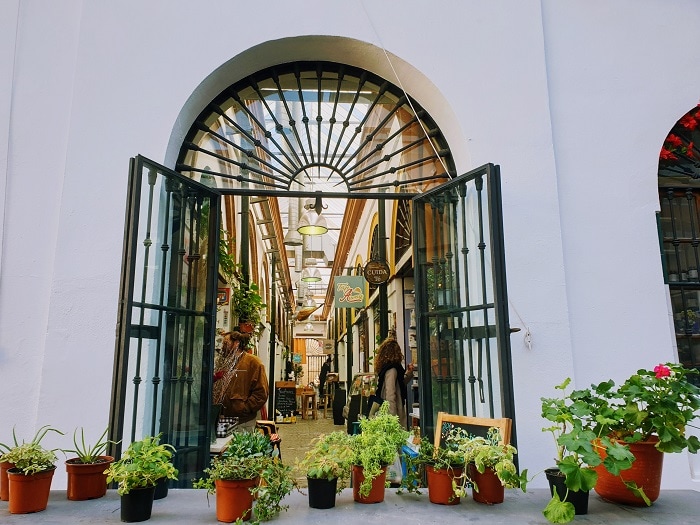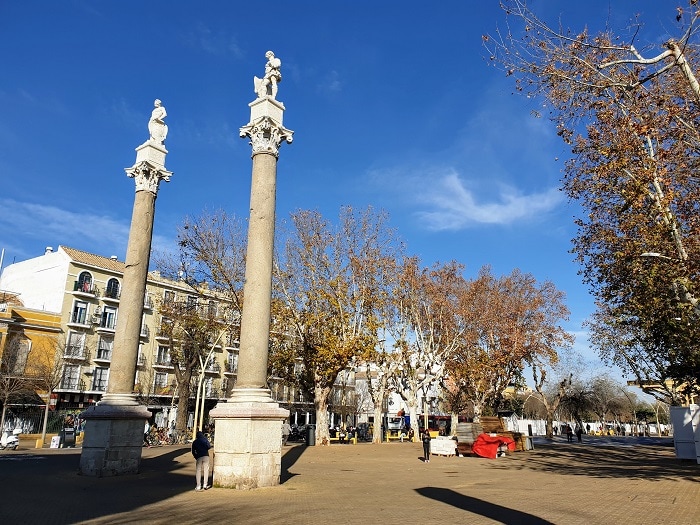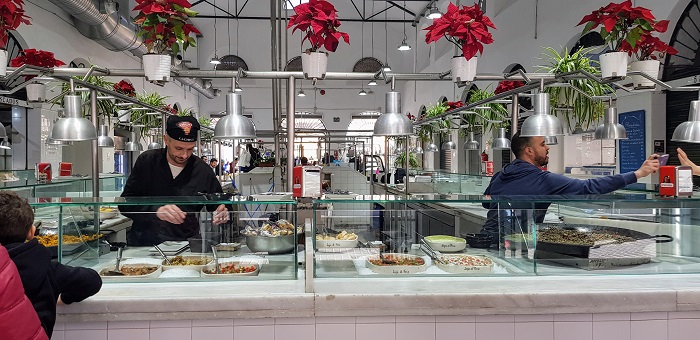The Giralda, the Alcázar and the Torre del Oro with the Guadalquivir are, without a doubt, the most sought after places by visitors. No wonder; they are a living symbol of the city. But the magic of Seville reaches far beyond them. That’s why we offer you these other gems which will surely not leave you indifferent.

Alameda de Hércules
This is the oldest public garden in Seville, and today it is the alternative area of the city. La Alameda brings together a very wide leisure offer, where you can find restaurants, bars and cafes of all kinds. Among its buildings, “La Casa de las Sirenas” stands out, a French-style building from the 19th century, an unusual architectural style in the city.
The most characteristic elements of La Alameda -apart from the shade cast by its trees- are the four columns that greet you, two on each side of the square. Interestingly, two of them are of Roman origin, and were brought from the old forum that was located in the current Plaza de La Alfalfa.

Alameda de Hércules, Sevilla
Mercado de Feria
Starting from the Alameda, if you go through Calle Relator, you will find El Mercado de la Calle Feria, the oldest civil building in the city, since it dates back to the 18th century. Today, it serves as a traditional market. In the mornings, vegetables and fresh fish take center stage. At midday, the bars open their doors, where the gastronomic offer ranges from fried fish to the tastiest hamburgers. To round it off, the setting couldn’t be more beautiful: in front of one of the entrances is the Palace of the Marqueses de La Algaba, the current Mudejar interpretation center.

Mercado de Feria. Interior
Arco de La Macarena and Muralla
The Holy Week in Seville cannot be understood without the arch of La Macarena, whose name is linked to the virgin that is also kept in the basilica of La Macarena, just behind it. During the Holy Week, every morning from Thursday to Good Friday, the Virgin processions go through the streets of Seville, passing under this popular arch.
The arch of La Macarena is its most recent name, but being one of the entrance gates to the city in ancient times, it was called the Royal Gate, since it was through this gate that the kings entered. Adjacent to the arch is one of the sections of the ancient city wall. Although the original was Roman, what we see is from the Muslim era.
Parliament of Andalusia, former Hospital of the Cinco Llagas (Five Wounds)
In front of the arch and the wall we find a Renaissance-style building that nowadays is the seat of the Parliament of Andalusia. Nonetheless, this building was built in the 16th century by a woman ahead of her time, Catalina de Ribera, as a hospital. At that time it was the largest building in Spain and for 200 years it was the largest hospital in Europe: it had 3,000 beds, very modern hygienic conditions such as sewers and a constant supply of clean water through an aqueduct. It functioned as a hospital until 1972, for over 400 years.
Los Corralones del Pelícano
In this place you will not see big buildings. Neither will you find any bars. But it is not to be missed. The corralones of the Plaza de El Pelícano are a deeply unknown corner where magic arises: ceramic craftsmen, carpenters, painters, flamenco dancers spend hours there, in the garages that make it up; either teaching their art, or delving into it. We recommend you take a walk there in silence, so that the sound of the lathe, the flamenco heel tapping and the tuned guitar can reach you.
La Isla de La Cartuja
In 1992 the city of Seville changed its structure thanks to a historic event: The Universal Exhibition that was held in this city, specifically on the Island of La Cartuja. Located on the other side of the river, crossing the La Barqueta bridge, you will find the buildings that once surprised the world. The Expo was a complete display of modernity, so if you walk through the area, you will surely be amazed by the Crystal Sphere or the Moroccan Pavilion. We recommend that you get lost in its streets and discover its corners, they will not leave you indifferent.
After discovering its pavilions, take a tour of the Monasterio de La Cartuja, a 13th century monastery that was restored for the ‘92 exhibition, and today is home to the city’s Museum of Contemporary Art. There are usually concerts on weekends.
Plaza Santa Isabel
If you are looking for a break on your trip, this hidden corner is a wonderful choice: Plaza de Santa Isabel, located between Vergara and Santa Paula streets. Although it is in the center of Seville, this square exudes tranquility. In the center of the square is a fountain. And behind it, the church of the convent of Santa Isabel. The orange trees are visible in spring, impregnating the place with the scent of orange blossom. If you wish to take a breather, this is without a doubt the perfect place.
Don’t forget to share this post!
Related Articles
↓
Sign up for our Newsletter and get the inside scoop on our favorite recipes,
exploring and devouring Spain and more.



